Related Flashcards
Related Topics
Cards In This Set
| Front | Back |
|
Cnidarians
|
Have Cnidocytes (capture prey and defence)Usually MarineDimorphic - Have sessile polyp and motile medusa phaseEx: Jellyfish, coralsBody plan: 2 layers of cells around central cavity. Radial symmetryMouth=anus "never kiss a Cnidarian!"
|
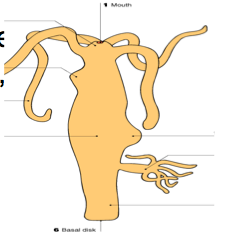 Hydra:a)Movement?b)Feeding Behaviour3)Cell types4)Reproduction |
1) Attach foot to substrate and extend tentaclesgliding, inching, somersaulting, floating on gas bubble from foot2) Carnivorous: Capture with tentacles and subdue with nematocystsPartial digestion in gastrovascular cavity, intracellular digestion in gastrodermal cells3) 1. Epitheliomuscular cells: epidermis=longitudinal gastrodermis=circular2.Cnidocytes: Have nematocysts triggered by cnidocils3. Neurons: Nerve net + sensory cells in epidermis4. Gland cells: Basal disc (to anchor to substrate) and Gastrodermis (secrete digestive enzymes5. Interstitial cells: Like stem cells (can divide and differentiate continuously)4) Sexual (internal): Some hermaphrodites. Union of games (from gonads - testes and ovaries)Asexual: Budding (mitosis)
|
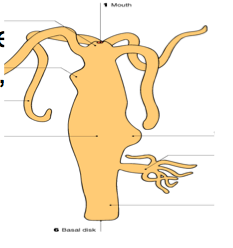 Histological Sections of Hydra |
HyptostomeTentacle (with cnidocycsts)Gastrovascular cavityBody column (epidermis, mesoglea, gastrodermis)Basal DiscBud
|
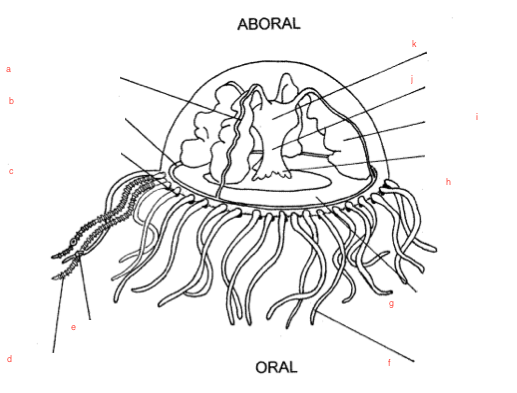 Gonionemus |
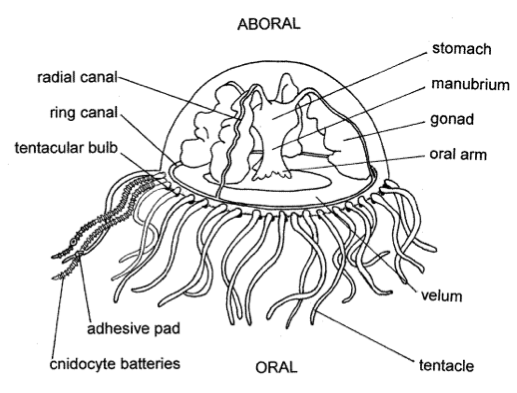 A) Radial canal - extensions of stomachb) Ring canal - part of gastrovascular systemc) Tentacular bulb - have interstitial cells to replace cnidocytesd) Cnidocytes - Arranged in batteries and each contain a nematocyst to stinge) Adhesive pad - f) Tentacleg) Velum - Help movement. Not present in jellyfishh) Oral lobe - Around mouth. Assist in ingestion.i) Gonad - Contain gametesj) Manubrium - Homologous to hyptostome in hydrak) Stomach - Extracellular digestion |
|
Gonionemus Reproduction
|
External. Eggs and sperm shed into water, fertilization. Fertilized egg develops into a small ciliated larva called the planula. Attaches to substrate and becomes a polyp. This polyp reproduces asexually by budding (each bud forms a new polyp). Eventually the polyps produce medusa buds.
|
|
Why would you have sexual AND asexual reproduction?
|
The probable reason for having two different strategies is due to the fact that the environment alternates between stable conditions and less stable conditions. One would hypothesize that if the environment remained stable for long periods of time (like in the digestive tract of a vertebrate), asexual reproduction would be the method most commonly used.
|
|
Phylum Annelida
|
Segmented wormsex: Earthworms, tube worms, leeches
|
|
External anatomy of common Earthworm
|
Epidermis secretes cuticle and mucusBilaterally symmetricalClitellum - secretes a mucus cocoon in which the eggs and sperm are depositedSetae - anchoring the worm for movement
|
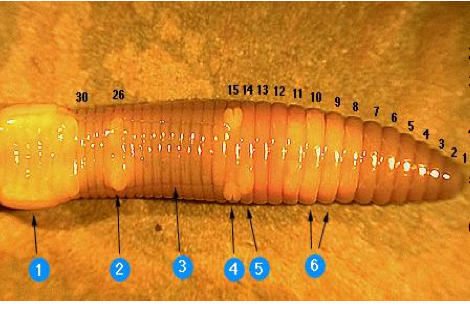 Segments of Earthworm |
~100 in total.1 - Mouth. Prostomium precedes mouth and the peristomium surrounds the mouth9/10 - Pores leading to seminal receptacles (store sperm14 - 2 female genital pores (where eggs released)15 - 2 male genital pores (where sperm are released. Sperm travels down two seminal grooves (run from 15 to clitellum)26 - Genital setae (hold ventral surfaces together during copulation)32-37 - Clitellum (secretes mucus cocoon)Final - anus
|
|
Earthworm Locomotion
|
Circular and longitudinal muscles work antagonistically with the hydrostatic skeleton. Setae anchor some segments while others are lengthening and shortening.
|
|
Earthworm Blood Circulation+Towards which direction does the blood travel in each vessel?
|
Dorsal blood vessel (travels anteriorly + one way valves)Ventral blood vessel (travels posteriorly)
|
|
Earthworm Coelom
|
True Coelom - fluid filled body cavity separated by septa (each is similar)
|
|
Earthworm Digestive System
|
Digestive tract from mouth to anus1. Mouth2. Pharynx - pulls soil and detritus in. Radial musces dilate the pharynx3. Esophagus - under aortic arches4. Crop - storage5. Gizzard - muscular and grinds up food6. Intestine - Digestible food and water absorbed by blood; indigestible food and soil eliminated by anus
Typhlosole: Large dorsal fold projecting into the lumen of the intestine. It increases the surface area. |
|
Earthworm Reproductive systemMale/female system, copulation, fertilization, etc.
|
(Receptacle, vesicle, receptacle, vesicle, vesicle)Hermaphrodites but cross fertilization.Male system: Seminal vesicles (seg. 10/11) store sperm. Testes are inside the vesicles. Sperm go from testes to vas deferens to male genital pores (seg. 15)Female system: Oviducts carry eggs from ovaries to female genital pores (seg. 14). Seminal receptacles (seg. 9/10) Store sperm from other worm.
Genital Setae (seg 10,11,26) - hold worms togetherSeminal grooves - sperm travel down these from the male genital pores to the seminal receptacles After copulation, clitellum secretes cocoon (chitinous material). Eggs then released from female genital pores into cocoon. Worm "backs" out of cocoon and eggs are fertilized as they pass over the seminal receptacles (external). Cocoon slips off and hardens and mucus tube disintegrates. |
|
Earthworm Circulatory System
|
Closed. Aortic arches (five pairs; like heart), ventral blood vessel, dorsal blood vessel.
|





